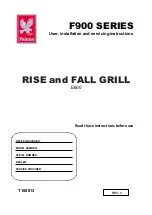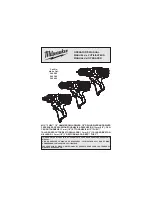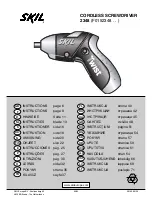
THANK YOU FOR BUYING A RYOBI PRODUCT.
To ensure your safety and satisfaction, carefully read through
this OWNER’S MANUAL before using the product.
General Safety Rules
WARNING!
Read all instructions.Failure to follow all instructions listed
below may result in electric shock,
fire
and/or serious injury. The term
“power tool” in all of the warnings listed below refers to your mains-
operated (corded) power tool or battery-operated (cordless) power
tool.
SAVE THESE INSTRUCTIONS
1)
Work area
a) Keep work area clean and well lit
. Cluttered and dark areas
invite accidents.
b) Do not operate power tools in explosive atmospheres,
such as in the presence of
fl
ammable liquids, gases or
dust.
Power tools create sparks which may ignite the dust or
fumes.
c) Keep children and bystanders away while operating a
power tool.
Distractions can cause you to lose control.
2)
Electrical safety
a) Power tool plugs must match the outlet. Never modify
the plug in any way. Do not use any adapter plugs with
earthed (grounded) power tools.
Unmodified plugs and
matching outlets will reduce risk of electric shock
b) Avoid body contact with earthed or grounded surfaces
such as pipes, radiators, ranges and refrigerators.
There
is an increased risk of electric shock if your body is earthed or
grounded.
c) Do not expose power tools to rain or wet conditions.
Wa-
ter entering a power tool will increase the risk of electric shock.
d) Do not abuse the cord. Never use the cord for carrying,
pulling or unplugging the power tool. Keep cord away
from heat, oil, sharp edges or moving parts.
Damaged or
entangled cords increase the risk of electric shock.
e) When operating a power tool outdoors, use an extension
cord suitable for outdoor use.
Use of a cord suitable for out-
door use reduces the risk of electric shock.
3)
Personal safety
a) Stay alert, watch what you are doing and use common
sense when operating a power tool. Do not use a power
tool while you are tired or under the in
fl
uence of drugs,
alcohol or medication.
A moment of inattention while operat-
ing power tools may result in serious personal injury.
b) Use safety equipment. Always wear eye protection.
Safety
equipment such as dust mask, non-skid safety shoes, hard
hat, or hearing protection used for appropriate conditions will
reduce personal injuries.
c) Avoid accidental starting. Ensure the switch is in the off-
position before plugging in.
Carrying power tools with your
finger
on the switch or plugging in power tools that have the
switch on invites accidents.
d) Remove any adjusting key or wrench before turning the
power tool on.
A wrench or a key left attached to a rotating
part of the power tool may result in personal injury.
e) Do not overreach. Keep proper footing and balance at all
times.
This enables better control of the power tool in unex-
pected situations.
f) Dress properly. Do not wear loose clothing or jewellery.
Keep your hair, clothing and gloves away from moving
parts.
Loose clothes, jewellery or long hair can be caught in
moving parts.
g) If devices are provided for the connection of dust extrac-
tion and collection facilities, ensure these are connected
and properly used.
Use of these devices can reduce dust-
related hazards.
4)
Power tool use and care
a) Do not force the power tool. Use the correct power tool for
your application.
The correct power tool will do the job better
and safer at the rate for which it was designed.
b) Do not use the power tool if the switch does not turn it
on and off.
Any power tool that cannot be controlled with the
switch is dangerous and must be repaired.
c) Disconnect the plug from the power source and/or the
battery pack from the power tool
before making any ad-
justments, changing accessories, or storing power tools.
Such preventive safety measures reduce the risk of starting the
power tool accidentally.
d) Store idle power tools out of the reach of children and do
not allow persons unfamiliar with the power tool or these
instructions to operate the power tool.
Power tools are dan-
gerous in the hands of untrained users.
e) Maintain power tools. Check for misalignment or binding
of moving parts, breakage of parts and any other condi-
tion that may affect the power tools operation. If damaged,
have the power tool repaired before use.
Many accidents
are caused by poorly maintained power tools.
f) Keep cutting tools sharp and clean.
Properly maintained
cutting tools with sharp cutting edges are less likely to bind and
are easier to control.
g) Use the power tool, accessories and tool bits etc. in accor-
dance with these instructions and in the manner intended
for the particular type of power tool, taking into account
the working conditions and the work to be performed.
Use
of the power tool for operations different from those intended
could result in a hazardous situation.
5)
Service
a) Have your power tool serviced by a quali
fi
ed repair person
using only identical replacement parts.
This will ensure that
the safety of the power tool is maintained.
IMPACT DRILL SAFETY PRECAUTIONS
1.
Wear ear protectors with impact drills.
Exposure to noise
can cause hearing loss.
2.
Use auxiliary handles supplied with the tool.
Loss of
control can cause personal injury.
3. Make sure drill bit is securely mounted. An incorrectly mounted
bit is extremely dangerous since it can
fl
y off or break during
drilling.
4. Do not wear cloth gloves or a necktie since they could become
caught in a rotating bit.
5. Never touch the chuck or metal body parts when drilling walls,
floors,
or other surfaces covering electrical wiring. Hold the drill
only by the plastic handle to prevent electric shock.
6. While operating the workpiece must be held with the vise or the
clamp etc. securely, for preventing to move it by the drill rotation.
INSTRUCTIONS FOR SAFE HANDLING
1. Make sure that the tool is only connected to the voltage marked
on the name plate.
2. Never use the tool if its cover or any bolts are missing. If the
cover or bolts have been removed, replace them prior to use.
Maintain all parts in good working order.
3. Always secure tools when working in elevated positions.
4. Never touch the blade, drill bit, grinding wheel or other moving
parts during use.
5. Never start a tool when its rotating component is in contact with
the workpiece.
6. Never lay a tool down before its moving parts have come to a
complete stop.
7.
ACCESSORIES :
The use of accessories or attachments other
than those recommended in these instructions might present a
hazard.
8.
REPLACEMENT PARTS :
When servicing use only identical
replacement parts.
- 3 -
Summary of Contents for PD-550K
Page 1: ...PD 550K...
Page 2: ...1 5 8 1 9 3 4 2 7 8 9 10 11 12 13 14 15 16 17 18 19 20 21...
Page 3: ...4 2 1 17 1 6 2 4 3 5...
Page 6: ...5 NOTE...
Page 7: ...6 NOTE...
Page 8: ......


























